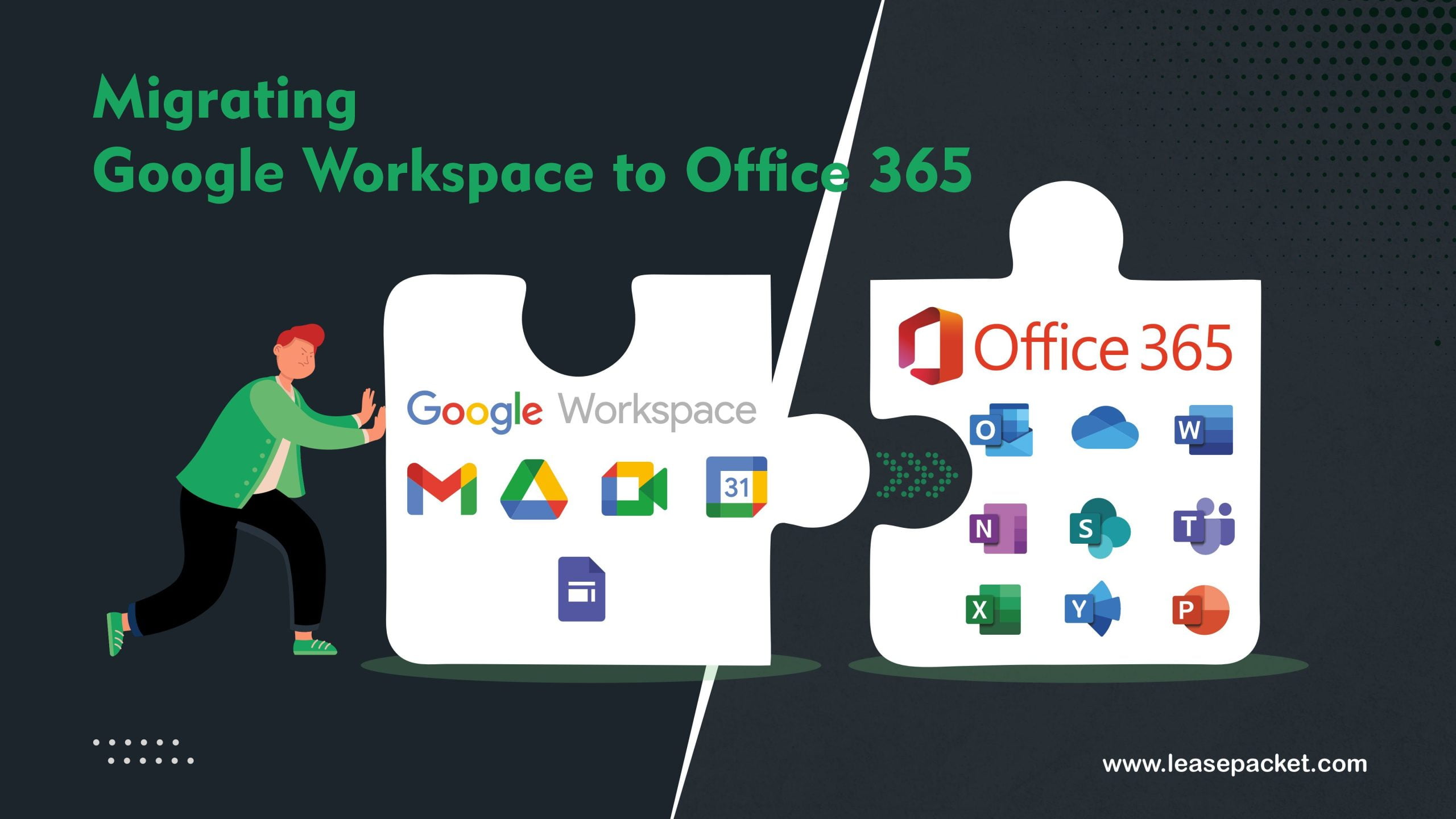Today, businesses often find themselves reevaluating their productivity tools & platforms to ensure they meet the increasing market demands. Two prominent options in this digital space are Google Workspace and Office 365 – a suite of cloud-powered productivity tools designed to assist companies in accomplishing their goals. This article is a complete guide to migrating from Google Workspace to Office 365 – exploring the reasons for migration, planning considerations, data migration strategies, and everything else.
Table of Contents
Overview of Google Workspace & Office 365
Google Workspace, previously known as G Suite, and Office 365, now rebranded as Microsoft 365 – stand as two titans in cloud-based productivity suites. Google Workspace boasts a suite of applications like Gmail, Google Drive, Docs, Sheets, and Slides – designed to foster collaboration & streamline workflow. Office 365, on the other hand, offers a similar suite of tools with a Microsoft touch, including Outlook, OneDrive, Word, Excel, PowerPoint, Teams, and SharePoint. Both platforms have revolutionized how businesses operate by providing a scalable, flexible, and accessible solution for communication, collaboration, and productivity needs.
1. Reasons for Considering a Migration
Organizations often contemplate migrating from Google Workspace to Office 365 for several reasons. It could be the need for smooth integration with other Microsoft products, such as Windows operating systems and Microsoft Office applications. Alternatively, compliance requirements or industry standards might dictate the switch to a platform like Office 365. Cost considerations, feature preferences, and organizational strategy also play pivotal roles in decision-making. Ultimately, the goal is to enhance productivity, streamline operations, and align with the evolving needs of the business.
2. Importance of planning & preparation
Planning & preparation form the bedrock of any successful migration endeavor. Before diving headfirst into the migration process, it’s better to analyze the current Google Workspace setup. This includes evaluating the number of users, data volume, service usage, and existing integrations. Understanding the organization’s unique needs, requirements, and objectives for moving to Office 365 is essential. Establishing clear shifting goals and objectives ensures the migration process remains focused, purposeful, and aligned with the overarching business strategy.
3. Understanding Google Workspace & Office 365
Google Workspace & Office 365 represent two leading cloud-based productivity suites used worldwide. While both platforms offer similar services, such as email, document editing, and collaboration tools – understanding their differences is crucial to making a successful migration decision. Google Workspace, known for its simplicity & real-time collaboration features, includes Gmail, Google Drive, Docs, Sheets, Slides, and more. On the other hand, Office 365, now known as Microsoft 365, offers a comprehensive suite of applications, including Outlook, OneDrive, Word, Excel, PowerPoint, Teams, and SharePoint. One significant difference lies in their pricing models, with Google Workspace offering straightforward pricing plans – while Office 365 provides various subscription tiers with differing feature sets.
Features & services offered by both platforms
Google Workspace & Office 365 offer various features & services aimed at empowering organizations to boost productivity. Google Workspace’s strength lies in its simplicity, ease of use, and real-time collaboration capabilities. With Gmail as its cornerstone, Google Workspace smoothly integrates email, document editing, cloud storage, and communication tools. In contrast, Office 365 provides a broad suite of applications deeply ingrained in the corporate world. From Outlook for email management to Teams for seamless collaboration and SharePoint for document management – Office 365 offers a robust ecosystem tailored to meet diverse modern business needs.
1. Primary differences in pricing & subscription models
One of the critical factors influencing the migration decision is the pricing and subscription models offered by Google Workspace & Office 365. Google Workspace offers straightforward monthly pricing plans with different tiers based on features and storage capacity. Office 365, however, has a variety of subscription tiers, each catering to different organizational needs & budgets. From basic plans targeted at small businesses to enterprise-level suites with advanced security features and compliance tools – Office 365 provides a scalable pricing model that can accommodate organizations of all sizes.
2. Compatibility considerations for data migration
Compatibility considerations are crucial in ensuring a smooth move from Google Workspace to Office 365. Data migration encompasses various components, including email, calendars, contacts, and files stored in Google Drive. It’s essential to assess the compatibility of data formats, file types, and third-party integrations between the two platforms. Understanding potential compatibility issues upfront allows organizations to mitigate risks, plan accordingly, and leverage migration tools and services to facilitate a smooth transition.
Preparing for Migration
Before embarking on a migration journey, thorough preparation is essential to ensure a smooth transition. Begin by assessing your current Google Workspace setup, including the number of users, storage usage, and specific services utilized. Evaluate your business requirements, considering factors – like regulatory compliance, data residency, and integration with other systems. Establish clear migration goals and objectives, outlining what you aim to achieve by migrating to Office 365, whether it’s enhanced collaboration, improved security, or cost savings.
1. Assessing the current Google Workspace setup
Before embarking on the migration journey, organizations must conduct their Google Workspace’s complete assessment. This involves gathering data on the number of users, storage usage, service utilization, and any existing integrations or customizations. Gaining insights into the existing setup can help in migration strategy, timeline, and resource allocation.
2. Evaluating user needs & requirements
User-centricity is everything when preparing for migration. Organizations must consider their unique needs, preferences, and workflows. This entails gathering feedback, conducting surveys, and engaging stakeholders to understand their expectations & priorities. By involving users in the migration planning process, organizations can ensure a smoother transition and foster greater user adoption and satisfaction post-migration.
3. Establishing migration goals & objectives
Setting clear migration goals & objectives is essential for driving alignment and accountability throughout the migration process. Whether the goal is to improve collaboration, enhance security, or optimize costs, organizations must define measurable objectives that align with their overarching business strategy. Establishing a roadmap with clear milestones, timelines, and success criteria provides a framework for tracking progress, identifying risks, and making informed decisions.
Data Migration Strategies
Migrating data from Google Workspace to Office 365 encompasses various components, including email, calendars, contacts, and files stored in Google Drive. Each of these requires a tailored migration strategy to ensure a successful transition. For email migration, organizations can utilize tools provided by Microsoft, such as the Exchange Online Migration tool or third-party solutions to transfer emails, folders, and labels from Gmail to Outlook. Similarly, calendar & contacts migration methods vary depending on the complexity of the data and the desired outcome. File migration from Google Drive to OneDrive or SharePoint can be achieved using migration tools or manual methods, taking into account file permissions, metadata, and folder structures.
1. Email migration options & best practices
Email migration is often one of the most critical components of the migration process. Organizations have several options for migrating email data from Google Workspace to Office 365, each with its pros & cons. IMAP migration, for instance, offers a straightforward method for migrating emails; however, it may not support advanced features like calendar & contact synchronization. Exchange Online provides a more robust solution for migrating emails, calendars, and contacts. Regardless of the migration method chosen, organizations must adhere to best practices, such as conducting thorough testing, communicating with users, and planning for downtime to minimize disruptions.
2. Calendar & contacts migration methods
Migrating calendar & contacts data requires careful planning to ensure data integrity and continuity of operations. Organizations can utilize various methods for their shift, including exporting data to CSV files, using migration tools provided by Microsoft, or leveraging third-party solutions. It’s essential to consider factors such as data format compatibility, synchronization capabilities, and user experience while selecting the appropriate migration method. Testing the migration process thoroughly and communicating with users about potential disruptions or changes are essential in ensuring a smooth transition.
3. File migration methods for Google Drive
File migration from Google Drive to Office 365 presents its unique challenges. Organizations must evaluate factors such as file permissions, metadata, folder structures, and versioning while planning the migration. Depending on the volume and complexity of the data, businesses can choose from manual migration methods, such as downloading and re-uploading files, or automated migration tools that streamline the process. It’s essential to tell users about the migration timeline, provide training and support as needed, and conduct post-migration checks to ensure data completeness and accuracy.
Planning for User Training & Adoption
User training and adoption play a critical role in the success of any migration project. It’s essential to equip users with the knowledge & skills required to effectively utilize the new platform and embrace change positively. Create comprehensive training materials and resources tailored to different user groups, covering basic functionalities and advanced features offered by the migrated suit. Consider conducting training sessions, workshops, or webinars to address specific user needs and encourage participation. Additionally, establish a support system to address user questions, concerns, and feedback throughout the migration process.
1. Importance of user education and support
User training & support are critical components of a successful migration strategy. Transitioning to a new platform like Office 365 can be daunting for users if they are accustomed to using Google Workspace. Providing training materials, resources, and support channels helps users navigate the transition smoothly and build confidence about the new platform.
2. Creating training materials & resources
Organizations must develop training materials and resources helpful for user needs & preferences. This may include video tutorials, user guides, cheat sheets, or interactive online courses covering basic & advanced functionalities offered by Office 365. Tailoring training materials to specific user groups and job roles ensures relevance and effectiveness in driving user adoption.
3. Strategies for promoting user adoption & engagement
Driving user adoption requires a multifaceted approach that goes beyond training & education. Organizations can use gamification, incentives, and peer-to-peer support networks. Encouraging feedback, requesting input from users, and addressing concerns or challenges in real-time demonstrate a commitment to user-centricity.
Managing Change & Communication
Effective communication and change management are essential components of a successful migration initiative. Communicate migration plans, timelines, and expectations to all stakeholders, including leadership, IT teams, and end-users. Address any concerns or apprehensions upfront, emphasizing the benefits of the migration and how it aligns with organizational objectives. Implement a structured change management strategy that includes regular updates, feedback mechanisms, and channels for resolving issues promptly. Encourage open communication and transparency to foster a culture of trust and collaboration during the transition period.
1. Communicating migration plans to co-owners
Clear and transparent communication is crucial throughout the migration process. Organizations must communicate migration plans, timelines, and expectations effectively to all stakeholders. Providing regular updates, addressing concerns, and soliciting feedback fosters trust, transparency, and buy-in from stakeholders and promotes a sense of ownership and accountability.
2. Addressing concerns & managing expectations
Change can be unsettling for organizations if it involves transitioning to a new platform. Proactively addressing concerns, managing expectations, and addressing resistance to change is essential for a smooth migration process. Organizations must create channels for open communication, provide opportunities for feedback, and address concerns or misconceptions promptly to alleviate anxiety and build confidence in the migration initiative.
3. Implementing a change management strategy
A structured change management strategy is essential for driving successful migration. This involves identifying key stakeholders, defining clear roles and responsibilities, and establishing communication channels and support mechanisms. Engaging stakeholders early in the process and providing ongoing training & support help maintain momentum and drive positive change.
Executing the Migration
With careful planning and preparation, it’s time to execute the migration according to the defined strategy. Start by conducting a pilot migration to test the process and identify potential challenges. Once validated, proceed with migrating data in batches, starting with critical components such as email & calendars, followed by files and other services. Monitor the migration progress closely, ensuring data integrity, completeness, and adherence to timelines. Address any issues or discrepancies promptly using migration tools and support resources from third parties.
1. A step-by-step guide to migrating Google Workspace to Office 365
Executing the migration requires careful planning, coordination, and execution to minimize disruptions and ensure data integrity. Organizations must follow a systematic procedure for moving critical components such as email, calendars, and contacts, followed by files and other services. Testing migration processes, validating data integrity, and communicating with users throughout the process are essential steps for a smooth transition.
2. Testing migration processes & validating data integrity
Thorough testing & validation are critical to the success of any migration initiative. Organizations must conduct complete testing of migration processes. Validating data integrity, user access, and application functionality post-migration helps identify and address any issues or discrepancies to minimize disruptions.
3. Troubleshooting common migration issues
Despite meticulous planning and preparation, migration projects may encounter unforeseen challenges or issues. It’s essential to anticipate potential risks, have contingency plans, and leverage migration tools and support resources to troubleshoot common migration issues. Communicating proactively with stakeholders, providing timely updates, and collaborating with internal and external teams help address challenges effectively and minimize the impact on users and business operations.
Post-Migration Considerations
Once the migration is complete, it’s better to do thorough post-migration checks to ensure a smooth transition to Office 365. Verify the completeness and accuracy of migrated data, conducting user acceptance testing to validate functionality. Configure Office 365 settings and preferences according to organizational policies and user preferences, including security settings, access controls, and collaboration features. Provide ongoing support and assistance to users, addressing any post-migration issues or questions to minimize disruptions and maximize productivity.
1. Verifying data completeness & accuracy
Post-migration checks ensure data completeness, accuracy, and integrity. Organizations must conduct thorough audits of migrated data to identify any anomalies. Comparing source & destination data and checking metadata & user acceptance testing help validate data integrity.
2. Configuring Office 365 settings & preferences
Configuring Office 365 settings according to organizational policies and user preferences is a critical post-migration task. This includes setting up user accounts, configuring security settings, access controls, and collaboration features, and customizing user interfaces to align with usability requirements. Providing guidance & support to users during the configuration process helps ensure a consistent and user-friendly experience across the organization.
3. Providing ongoing support & assistance to users
Supporting users post-migration is essential for driving adoption and maximizing the benefits of Office 365. Organizations must establish support channels to address user concerns. Providing ongoing training helps users navigate the new platform confidently.
Optimizing & Maximizing Office 365 Benefits
Beyond the initial migration phase, organizations can leverage Office 365’s advanced capabilities to further optimize productivity. Explore integration opportunities with other Microsoft tools, like Power BI, Power Automate, and Dynamics 365 for business processes. Monitor usage and performance metrics using built-in analytics tools to identify areas for improvement. Continuously evaluate and refine your Office 365 deployment to ensure alignment with evolving business needs and industry trends.
1. Leveraging advanced features
Office 365 offers many advanced features that organizations can use to optimize productivity & innovation. From advanced security and compliance tools to AI-powered productivity features and intelligent automation – Office 365 provides a suite of solutions tailored to meet the diverse needs of modern businesses. Organizations must use these features to their fullest potential to drive success & gain competitive advantage.
2. Integrating Office 365 with other tools & services
Integrating Office 365 with other Microsoft tools & services unlocks new possibilities for streamlining workflows, automating processes, and driving business insights. Organizations can leverage integrations with Power BI for advanced analytics and reporting, Power Automate for workflow automation, and Dynamics 365 for CRM & ERP capabilities. By integrating Office 365 with other business applications, organizations can create a connected ecosystem that drives efficiency.
3. Monitoring usage & performance for continuous improvement
Monitoring performance metrics is essential for optimizing Office 365 deployment and driving continuous improvement. Organizations must track key performance indicators, such as user adoption rates, system uptime, and user satisfaction scores – to identify areas for improvement and drive targeted interventions. With built-in analytics tools like Microsoft 365 usage analytics, businesses can gain valuable insights into user behavior and system performance for data-driven decision-making.
Conclusion
Migrating from Google Workspace to Office 365 requires careful planning, execution, and ongoing optimization to maximize the benefits of the transition. By understanding the nuances of both platforms, preparing thoroughly, and engaging users effectively – organizations can ensure a smooth migration experience and unlock the full potential of Office 365’s productivity suite. Remember that migration is not just a technical process but also a cultural shift, requiring proactive communication and support to drive success.
FAQs
Q1. What are the key benefits of migrating from Google Workspace to Office 365?
Office 365 offers smooth integration with other Microsoft products, advanced security features, and a complete suite of productivity tools tailored to meet the diverse needs of modern businesses.
Q2. How long does the migration process typically take?
The duration of the migration process varies depending on factors such as the organization size, the complexity of data, and the chosen migration method. Generally, migrations take from a few days to several weeks to complete.
Q3. What are the common challenges associated with data migration?
Common challenges include compatibility issues between Google Workspace and Office 365, data integrity concerns, and user resistance to change. Proper planning, testing, and communication can help mitigate these challenges and ensure a smooth transition.
Q4. Do I need to train my users before migrating to Office 365?
Yes, providing training & support to users before and after the migration is crucial for driving adoption and maximizing the benefits of Office 365. Training materials, resources, and support channels should be formed.
Q5. How can organizations keep data secure during the migration process?
Organizations should implement robust security measures, such as encryption, access controls, and data loss prevention policies, to safeguard sensitive information and mitigate risks.
Q6. What support resources are available for organizations migrating to Office 365?
Microsoft offers various support resources for organizations migrating to Office 365, including migration tools, documentation, training materials, and online communities. Additionally, third-party vendors and consultants specialize in assisting organizations with migration planning, execution, and support.
How to get help for migration?
You can hire top server agencies like Leasepacket to get migration help. They handle the A to Z process.

























